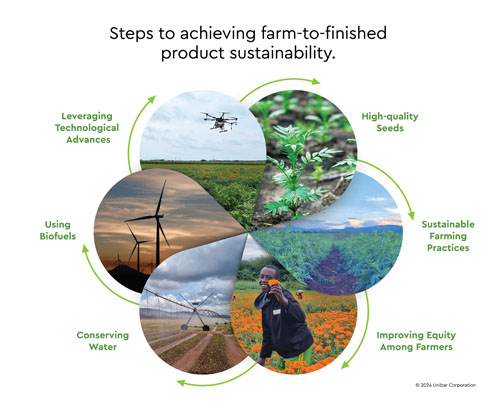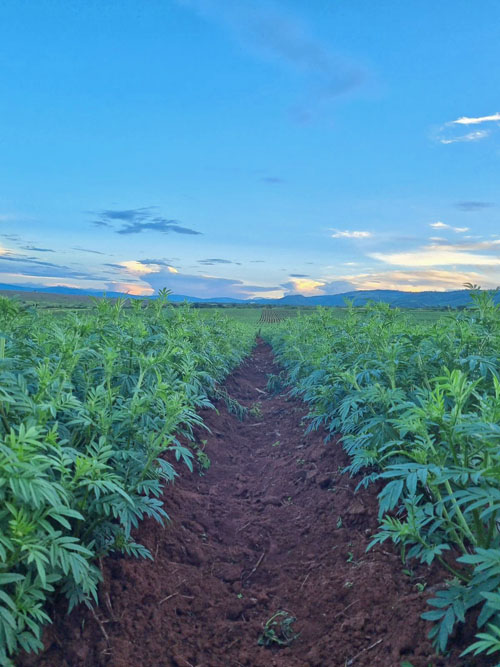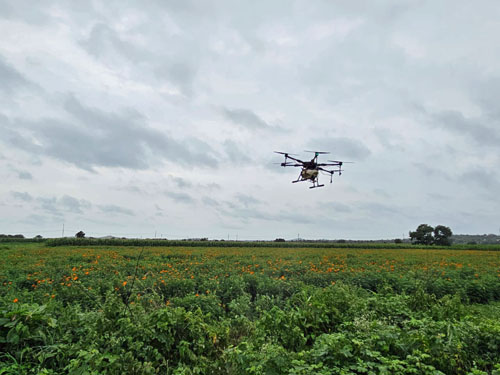Beyond the breathtaking view and eye health benefits they provide, these golden gems have a rich and colourful history — from their use in ancient Aztec rituals to wedding ceremonies and temple offerings in India to Africa. Offered to the Virgin Mary in place of gold, “Mary’s Gold” eventually became marigold.1
Traditionally, marigolds thrive in India and Africa and are planted in the spring and summer. It takes about 7–10 days to germinate and, following this, anywhere from 50–90 days to flower, depending on the variety.2
Benefits of marigolds for human health
George Wald, a renowned scientist, was the first to discover lutein and zeaxanthin (key actives in marigold flowers) in the macula and the role that these carotenoids played in vision health.3
Long before lutein and zeaxanthin were extracted from marigold flowers, Tagetes erecta (African Marigold) was historically used for skin health, healthy digestion and even immune benefits.4

Most of us don’t get sufficient lutein intake from our diet alone; the average global intake ranges from 1–2 mg per day, significantly less than the recommended 10–20 mg per day.5
A key turning point in lutein and zeaxanthin awareness and the critical need for these carotenoids for vision health occurred following the publication of the well-known AREDS2 clinical trial results.
This double-blind, multicentred, randomised, placebo-controlled study suggested that lutein and zeaxanthin may help to reduce the risk of progression to advanced macular degeneration (AMD).6
More recent research during the past two decades has shown that lutein and zeaxanthin can filter blue light, provide antioxidant benefits for skin health and support episodic memory and visual learning.3,7,8
The awareness and importance of carotenoid supplementation for eye health has grown exponentially. Globally, the dietary supplement market for eye health is valued at $1.83 billion, with the United States accounting for nearly a billion dollars in eye health supplement sales.9,10
Lutein and zeaxanthin-based eye health supplements account for the largest market share (33%).9 Unfortunately, this meteoric increase in lutein-based eye health supplements has also created a rampant rise in “bad actors” trying to make quick profits.
From adulteration with cheaper ingredients to the mistreatment of farmers, there is no shortage of unethical production and irresponsible sourcing practices.11
The seed of the matter
According to a recently published article in the Journal of Natural Products, economic gains, supply chain shortages and increased demand are some of the critical causes of ingredient adulteration.12
This issue is only expected to be exacerbated as climate change negatively impacts soil fertility, crop yields and the nutrient composition of extracted ingredients.13 Rather than waiting for this issue to come to fruition, the time to start identifying solutions and implementing sustainability initiatives is now.
Climate, soil conditions, seed varieties and extraction processes all significantly affect the quality and efficacy of an ingredient. Of additional importance beyond these inputs are the growers and farmers who are at the heart of the natural products supply chain.

When it comes to identifying sustainable solutions, it is critical to collaborate with the local farming community in the region.
Take, for example, marigold flower cultivation in Africa (by Unibar and its partners) for lutein and zeaxanthin. A co-op farming culture provides marigold growers in Africa with training opportunities regarding modern agriculture practices, access to high-quality seeds and resources to harvest marigold flowers sustainably.
In addition to finding the right partners, an equally important objective for brands and ingredient suppliers should be to build a more equitable and resilient supply chain. This starts with fair compensation (such as doubling their salaries) to farmers and nutritional support for their families.
When talking about sustainability, one can’t forget about water usage. Agriculture is responsible for nearly 70% of the global demand for fresh water.14
As climate change intensifies the pressure on water resources globally, the natural products community will need to identify unique ways to collect water and ensure efficient use.
Precise irrigation techniques such as drip irrigation, pivot irrigation and rain pipe irrigation will need to become commonplace to help ensure efficient water utilisation and reduce water usage.
These techniques can minimise water usage by 40–60%, equalling the conservation of close to 133.7 million litres of water each year. We are experiencing this first hand as our African marigold operation is on track to record these water savings in 2024.
Technology: an essential sustainability pillar
According to the United Nations, the global population is anticipated to reach close to 10 billion people by 2050.15
Sustainably feeding and meeting the nutritional demands of this growing population will require systematic changes to current agriculture practices, all in an effort to improve efficiency, conserve resources and increase yields. Artificial intelligence (AI) and technological advances could be the key to reshaping sustainable agriculture.16
Take, for example, our practice of geotagging marigold farms. This refers to the process of attaching geographical co-ordinates (latitude and longitude) to specific locations on a farm, such as fields, boundaries, water sources, crop zones or equipment. This mapping enables better management of large and complex farm operations.

From creating virtual boundaries (geofences) for areas of farms that need additional inputs to monitoring historical datasets to develop improved seed varieties, the use of sensors, drones and other connected technologies helps our marigold farmers to improve crop yields and reduce waste.
Leveraging technology to enact impactful changes at the farm is only one part of the equation. According to the United States Environmental Protection Agency, burning coal, natural gas and oil for electricity and heat is the single largest source of global greenhouse gas emissions.17
Transitioning to clean energy technology will be a prerequisite to reduce emissions.18 At our production facilities globally, we have started using biofuels such as coffee husks and spent marigolds for renewable energy to significantly reduce carbon dioxide emissions (approximately 228 tons annually).
A sustainable supply chain is a win for everyone
A recent survey by Ipsos, a multinational market research firm, in partnership with IADSA (International Alliance of Dietary Food Supplement Associations), highlighted how vital and relevant sustainability is to companies and brands within the natural products category.19
However, the limiting factor for many is the cost of implementing sustainable practices. What many don’t realise is the changing consumer dynamic and willingness to pay for more sustainable goods.
According to the recent 2024 Voice of the Customer Survey by PwC (PricewaterhouseCoopers International), which surveyed more than 20,000 individuals, consumers are willing to spend 9.7% more on sustainably produced or sourced goods, even with the rising cost-of-living and inflationary pressures.20
When double-clicking on consumer purchase behaviour by generation, Gen Z and Millennial customers are 27% more likely than older generations to spend on brands they believe care about people and the planet.21
This is an important consideration for many brands because, by the end of this decade, the purchasing power of Millennials and Gen Z will surpass that of Boomers.
Although committing to sustainability initiatives can feel daunting, there are frameworks such as the Farm Sustainability Assessment (FSA) from the Sustainable Agriculture Initiative (SAI) Platform that help ingredient suppliers and brands to benchmark their current programmes and set in place improvements for the future.
By following the FSA frameworks and employing environmentally friendly farming practices, from growing conditions to extraction, we’ve seen improved success — with a 66% increase in the quantities of marigolds and isolates extracted per hectare.
The upshot is that traceable and sustainable supply chains help us to mitigate the devastating effects of climate change, yield more nutrients and positively impact the bottom line.
References
- www.blueridgebotanic.com/blog/marigolds-a-sunny-little-flower-with-a-rich-amp-colorful-history.
- www.bootstrapfarmer.com/blogs/growing-flowers/marigold-cultivation-for-flower-farmers.
- https://doi.org/10.3390/nu14040827.
- www.gaiaherbs.com/blogs/herbs/marigold.
- https://doi.org/10.1016/j.fbio.2024.104085.
- https://doi.org/10.1001/jama.2013.4997.
- https://doi.org/10.1016/j.clindermatol.2008.01.011.
- https://doi.org/10.3389/fnut.2022.843512.
- www.grandviewresearch.com/industry-analysis/eye-health-supplements-market.
- M. Brush, “Looking Beyond Blue Light,” Nutrition Business Journal (Condition Specific Issue): 22–26 (2024).
- www.nutraingredients.com/Article/2014/04/11/Over-50-of-French-eye-health-supps-contain-illegal-meso-zeaxanthin.
- https://doi.org/10.1021/acs.jnatprod.2c00929.
- https://doi.org/10.3389/fclim.2022.941842.
- https://doi.org/10.1016/j.heliyon.2023.e18507.
- www.un.org/en/global-issues/population.
- www.sciencedaily.com/releases/2024/06/240618115419.htm.
- www.epa.gov/ghgemissions/global-greenhouse-gas-overview.
- www.iea.org/reports/energy-technology-perspectives-2020.
- www.iadsa.org/sustainability-report.
- www.pwc.com/gx/en/issues/c-suite-insights/voice-of-the-consumer-survey.html.
- https://hbr.org/2023/09/research-consumers-sustainability-demands-are-rising.
